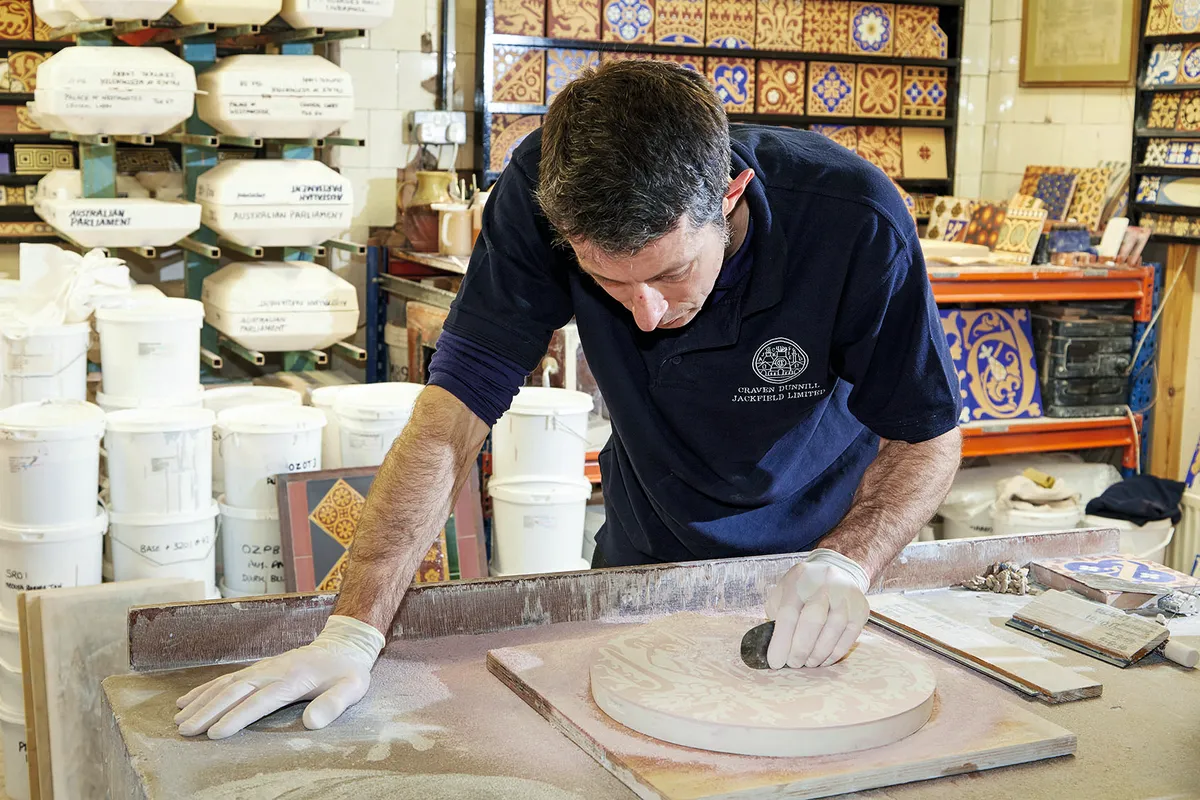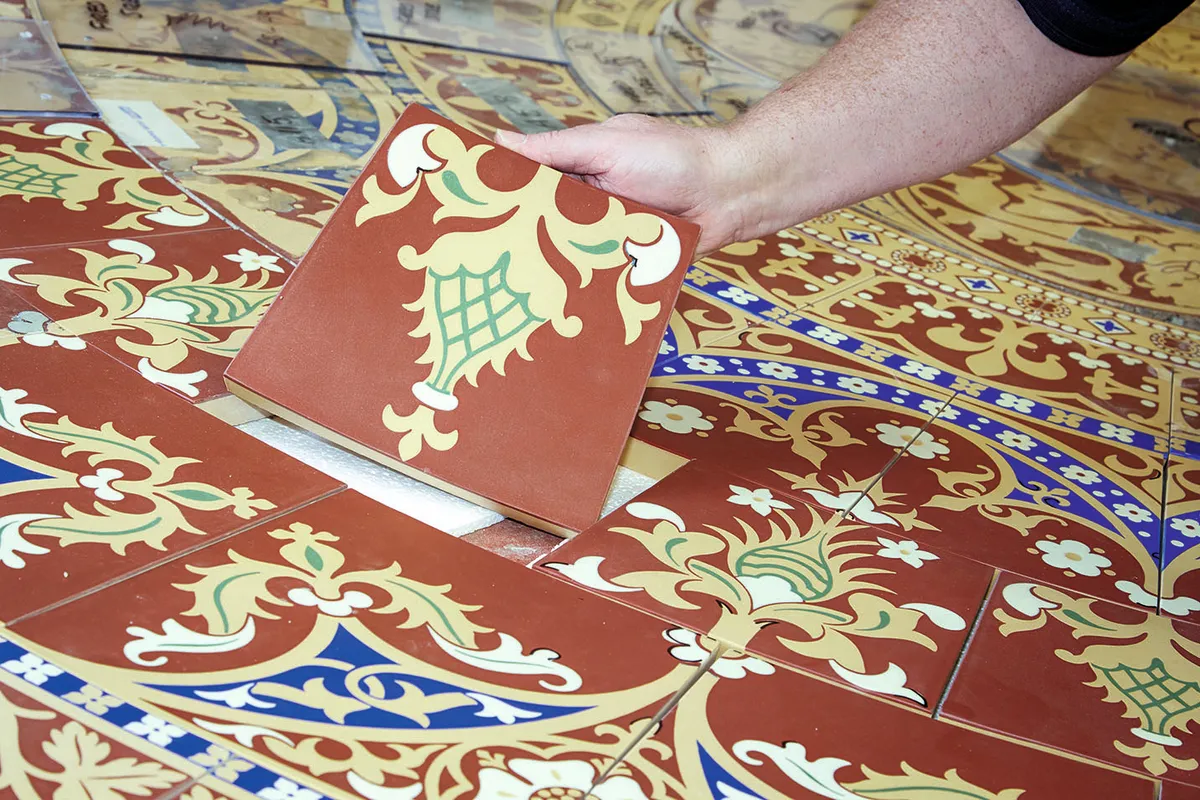Beneath mosaic vaults and a looming octagon tower, politicians have long mingled in the central lobby that lies at the core of the Palace of Westminster. But should they seek inspiration as they exchange opinion and defend arguments, their attention may be drawn down, as easily as up.
They are standing on richly patterned encaustic floor tiles designed by Augustus Pugin, a key component in his iconic Gothic Revival interior. Yet appearances can be deceptive: most of the tiles weren’t made in the 19th century but in the far more recent past.
Replacements on a large scale became necessary because, after decades of wear, many of the originals made by Minton were damaged beyond repair. Enter Craven Dunnill Jackfield, leading makers of traditional tiles and ‘one of the best-kept secrets around’, as Adrian Blundell, production manager, puts it.

‘We use exactly the same techniques the Victorians did. We still hand-dip all our plain glazed tiles; we use metal oxides in our glazes, which create an almost stained-glass effect on the surface.’ That said, he and the team regard their work at Westminster Palace (they also restored floors in the Members’ Entrance, St Stephen’s Hall and the Royal Gallery) as a landmark commission.
‘It was a 12-year project, an amazing journey. In the first years we developed a new suite of clays, looking at durability and staining resistance to make sure that the floor that went down outlasted the floor that was there, but looked the same.’
As tile manufacturers with a long pedigree, the company was ideally qualified to take on such a prestigious commission. ‘Craven Dunnill was a very important Victorian tile manufacturer, and it was sited in what is now a national centre of tile history.
Part of the original factory is now a museum of tile history – a fascinating place,’ says ceramics expert Paul Atterbury.

Situated at Jackfield, Shropshire, at the heart of the ceramic manufacturing centre of Ironbridge Gorge, Craven Dunnill was founded by financier Henry Powell Dunnill in 1872. ‘Dunnill was an investor; the company had been going for a number of years under different names and partnerships, but once he got involved there was huge investment and the business flourished,’ says Adrian.
A new factory, appropriately built in the latest neo-Gothic style, was kitted out with state-of-the-art machinery. ‘The location took advantage of locally available materials and communications. Craven Dunnill became a leading maker of floor tiles and wall tiles, and could match the big names in the market, even though many of their designers are not so familiar as those associated with Minton,’ says Paul.
Six years after the opening, Frederick Charles Howells, the ambitious and talented 14-year-old son of a shoemaker, from the neighbouring town of Broseley, joined the workforce. Having learned the trade, he moved away, joining Pilkington as senior design manager. In 1915, irked at missing out on the Pilkington managing directorship, Howells left and returned to Craven Dunnill – now as its new owner.
‘Five generations on, descendants of the same family still own the company today. They are still heavily involved in its running, and that passion, the desire to keep history alive, and look at it in a new way, plus the fact that next year is our 150th anniversary, is unique and special,’ says Adrian.

Encaustic floor tiles, decorated with inlaid designs formed from differently coloured clays, were produced in large quantities during the company’s heyday. So too were mosaic tiles, moulded relief tiles and plain glazed tiles. All were used extensively in churches, municipal buildings, swimming pools, pubs, underground stations and private homes.
‘Along with Wedgwood and Minton, Craven Dunnill was in the Premier League. They were good at exporting, and global markets helped to establish their international status,’ says Paul Atterbury.
How has the company prospered when others have floundered? ‘It was quite nimble-footed, it was a small ownership, and could make decisions and be canny in the way they operated,’ explains Adrian.
Even so, he admits, manufacturing output hasn’t been constant. Tile production ceased in 1950, when the company moved to Bridgnorth to focus on distribution. The Jackfield site was later acquired by the Ironbridge Gorge Museum Trust, and part of it was developed as a museum. After 50 years, tile production resumed in 2000.

These days the company employs 26 people over two sites (the other is in Stoke-on-Trent) and as most of the company’s commissions are bespoke, employees are trained in different processes. ‘It isn’t all creative: if you have to produce 1,500 similar hand-dipped tiles, making sure they have the finish we require is a challenge and takes a certain type of person,’ says Adrian.
As they look to the future, expanding the range of tiles for the domestic market is high on the agenda. So too is increasing collaboration with contemporary artists such as Brian Clarke, Clare Woods and Frances Priest. ‘I’m particularly proud of the colourful wall-panel friezes made for the Royal Edinburgh Hospital designed by Frances Priest. Using the tiles seen in the porches of tenement buildings for inspiration, we brought colour and light to the building that was transformational,’ says Adrian.
Meanwhile, more traditional heritage commissions continue: ‘We are working on the restoration of Manchester Town Hall, and we have restored Harrods’ Food Hall recently. Unfortunately, there were no free food samples, but it was still wonderful.’
